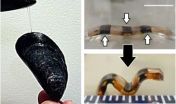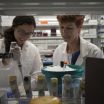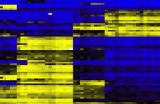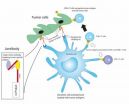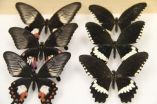(Press-News.org) A recent University of Oklahoma study of five decades of satellite data, model simulations and in situ observations suggests the impact of seasonal diurnal or daily warming varies between global regions affecting many ecosystem functions and services, such as food production, carbon sequestration and climate regulation. The effects of non-uniform climate warming on terrestrial ecosystems is a key challenge in carbon cycle research and for those making future predictions.
Jianyang Xia, a research associate in the OU College of Arts and Sciences, says the impact of non-uniform warming is just one aspect of climate change. Shifts in precipitation and disturbances, such as wildfires, increases in the frequency of extreme temperature events, large year-to-year shifts in temperature and shifts in regional climate zones can be expected as the climate warms. A complete understanding of the consequences of climate change for carbon cycling on land requires insight into the impact of all these changes on the ecosystem.
As this study suggests, the rate of climate warming varies by season and region, and between day and night. A synthesis of air temperature data from across the world reveals a greater rate of warming in winter than in summer in northern and high latitudes, but the inverse is true in some tropical regions.
Also, the data show a decline in the daily temperature range over 51 percent of the globe and an increase over only 13 percent, because night-time temperatures in most locations have risen faster than daytime temperatures.
From the data analyzed, a number of trends emerged in non-uniform climate warming for ecosystem carbon cycling. Spring warming will enhance ecosystem carbon uptake at high latitudes and diminish the magnitude of seasonal temperature change in these regions. Summer and autumn warming are more likely to reduce ecosystem carbon uptake in tropical ecosystems and amplify the magnitude of seasonal temperature change.
The contrasting impacts of day- and night-time warming on plant carbon gain and loss are apparent in many regions. Day warming increases carbon uptake in most areas of tundra and boreal forests but decreases it in most grasslands and deserts. Night warming enhances carbon uptake in arid ecosystems, such as grassland desert but has negative impacts in other regions.
Most of the existing temperature-manipulation experiments relied on continuous and uniform warming, so further research is needed to predict the effects of non-uniform climate warming on terrestrial carbon cycling.
INFORMATION:A paper on this study was accepted for early online publication on February 23, 2014, by Nature Geoscience. For more detailed information about this study, please contact Jianyang Xia at jxia@ou.edu or Yiqi Lou at ylou@ou.edu or visit the EcoLab website at http://ecolab.ou.edu.
OU study suggests non-uniform climate warming global
Affects terrestrial carbon cycle, ecosystems and future predictions
2014-03-05
ELSE PRESS RELEASES FROM THIS DATE:
A small step toward discovering habitable earths
2014-03-05
University of Arizona researchers snapped images of a planet outside our solar system with an Earth-based telescope using essentially the same type of imaging sensor found in digital cameras instead of an infrared detector. Although the technology still has a very long way to go, the accomplishment takes astronomers a small step closer to what will be needed to image earth-like planets around other stars
"This is an important next step in the search for exoplanets because imaging in visible light instead of infrared is what we likely have to do if we want to detect planets ...
Researchers find potential target for drug to treat allergic asthma
2014-03-05
COLUMBUS, Ohio – An enzyme that helps maintain immune system function by "throwing away" a specific protein has a vital role in controlling symptoms of allergic asthma, new research in mice suggests.
The finding suggests that this enzyme, called Cbl-b, could be a target for drugs used to treat allergic asthma and other autoimmune disorders.
This new study, led by Ohio State University researchers, is the first to link Cbl-b to allergic asthma in an animal model.
The findings parallel results from a 2012 Yale study in humans, which suggested that a mutation in the ...
Pumping iron: A hydrogel actuator with mussel tone
2014-03-05
Protein from a small, tasty mollusk inspired Michigan Technological University's Bruce P. Lee to invent a new type of hydrogel actuator.
Hydrogels are soft networks of polymers with high water content, like jello. Because of their soft, gentle texture, they have the potential to interact safely with living tissues and have applications in a number of medical areas, including tissue engineering. Lee, an assistant professor of biomedical engineering, wanted to make a hydrogel that wouldn't just sit there.
"Hydrogels that can change shape on command could be used to deliver ...
Going viral to target tumors
2014-03-05
March 5, 2014, New York, NY– A Ludwig Cancer Research study suggests that the clinical efficacy of checkpoint blockade, a powerful new strategy to harness the immune response to treat cancers, might be dramatically improved if combined with oncolytic virotherapy, an investigational intervention that employs viruses to destroy tumors.
Published today in the journal Science Translational Medicine, the study evaluated a combination therapy in which the Newcastle disease virus (NDV), a bird virus not ordinarily harmful to humans, is injected directly into one of two melanoma ...
Biomarkers of cell death in Alzheimer's reverse course after symptom onset
2014-03-05
Three promising biomarkers being studied to detect Alzheimer's disease in its early stages appear to undergo a surprising shift as patients develop symptoms of dementia, researchers at Washington University School of Medicine in St. Louis report.
Scientists use the biomarkers to assess brain changes linked to the disease in research volunteers. The levels of markers of neuronal injury increase in the spinal fluid for a decade or more before the onset of dementia, but in a new twist, the research shows for the first time that they later reverse course, decreasing as symptoms ...
An inventive new way to profile immune cells in blood
2014-03-05
ROVIDENCE, R.I. [Brown University] — When a person becomes sick or is exposed to an unwelcome substance, the body mobilizes specific proportions of different immune cells in the blood. Methods of discovering and detecting those profiles are therefore useful both clinically and in research. In a new paper in the journal Genome Biology, a team of scientists describes a new and uniquely advantageous way to detect them.
All the current means of counting immune cells in a blood sample require whole cells, said Karl Kelsey, professor of epidemiology at Brown and corresponding ...
Novel cancer vaccine holds promise against ovarian cancer, mesothelioma
2014-03-05
A novel approach to cancer immunotherapy – strategies designed to induce the immune system to attack cancer cells – may provide a new and cost-effective weapon against some of the most deadly tumors, including ovarian cancer and mesothelioma. Investigators from the Massachusetts General Hospital (MGH) Vaccine and Immunotherapy Center report in the Journal of Hematology & Oncology that a protein engineered to combine a molecule targeting a tumor-cell-surface antigen with another protein that stimulates several immune functions prolonged survival in animal models of both ...
Hungry for 'likes': Frequent Facebook use linked to eating disorder risk, study finds
2014-03-05
TALLAHASSEE, Fla. — Frequent Facebook users might be sharing more than party pictures, vacation videos and shameless selfies — they also share a greater risk of eating disorders, according to a new study led by Florida State University researchers.
Psychology Professor Pamela K. Keel studied 960 college women and found that more time on Facebook was associated with higher levels of disordered eating. Women who placed greater importance on receiving comments and "likes" on their status updates and were more likely to untag photos of themselves and compare their own photos ...
Prenatal nicotine exposure may lead to ADHD in future generations
2014-03-05
TALLAHASSEE, Fla. — Prenatal exposure to nicotine could manifest as attention deficit hyperactivity disorder in children born a generation later, according to a new study by Florida State University College of Medicine researchers.
Professors Pradeep G. Bhide and Jinmin Zhu have found evidence that ADHD associated with nicotine can be passed across generations. In other words, your child's ADHD might be an environmentally induced health condition inherited from your grandmother, who may have smoked cigarettes during pregnancy a long time ago. And the fact that you never ...
A single gene, doublesex, controls wing mimicry in butterflies
2014-03-05
A single gene regulates the complex wing patterns, colors and structures required for mimicry in swallowtail butterflies, report scientists from the University of Chicago, March 5 in Nature. Surprisingly, the gene described, doublesex, is already well-known for its critical role in sexual differentiation in insects.
"Conventional wisdom says that it should be multiple genes working together to control the whole wing pattern of a butterfly," said Marcus Kronforst, Neubauer Family Assistant Professor of Ecology & Evolution at the University of Chicago and senior author ...
LAST 30 PRESS RELEASES:
Scientists use ultrasound to soften and treat cancer tumors without damaging healthy tissue
Community swimming program for Black youth boosts skills, sense of belonging, study finds
Specific depressive symptoms in midlife linked to increased dementia risk
An ‘illuminating’ design sheds light on cholesterol
Who is more likely to get long COVID?
Study showcases resilience and rapid growth of “living rocks”
Naval Research Lab diver earns Office of Naval Research 2025 Sailor of the Year
New Mayo-led study establishes practical definition for rapidly progressive dementia
Fossil fuel industry’s “climate false solutions” reinforce its power and aggravate environmental injustice
Researchers reveal bias in a widely used measure of algorithm performance
Alcohol causes cancer. A study from IOCB Prague confirms damage to DNA and shows how cells defend against it
Hidden viruses in wastewater treatment may shape public health risks, study finds
Unlock the power of nature: how biomass can transform climate mitigation
Biochar reshapes hidden soil microbes that capture carbon dioxide in farmland
Reducing saturated fat intake shows mortality benefit, but only in high-risk individuals
Manta rays create mobile ecosystems, study finds
Study: Mixed results in using lipoic acid to treat progressive multiple sclerosis
Norbert Holtkamp appointed director of Fermi National Accelerator Laboratory
New agentic AI platform accelerates advanced optics design
Biologists discover neurons use physical signals — not electricity — to stabilize communication
Researchers discover that a hormone can access the brain by hitchhiking
University of Oklahoma researcher awarded funding to pursue AI-powered material design
Exploring how the visual system recovers following injury
Support for parents with infants at pediatric check-ups leads to better reading and math skills in elementary school
Kids’ behavioral health is a growing share of family health costs
Day & night: Cancer disrupts the brain’s natural rhythm
COVID-19 vaccination significantly reduces risk to pregnant women and baby
The role of vaccination in maternal and perinatal outcomes associated with COVID-19 in pregnancy
Mayo Clinic smartwatch system helps parents shorten and defuse children's severe tantrums early
Behavioral health spending spikes to 40% of all children’s health expenditures, nearly doubling in a decade
[Press-News.org] OU study suggests non-uniform climate warming globalAffects terrestrial carbon cycle, ecosystems and future predictions

